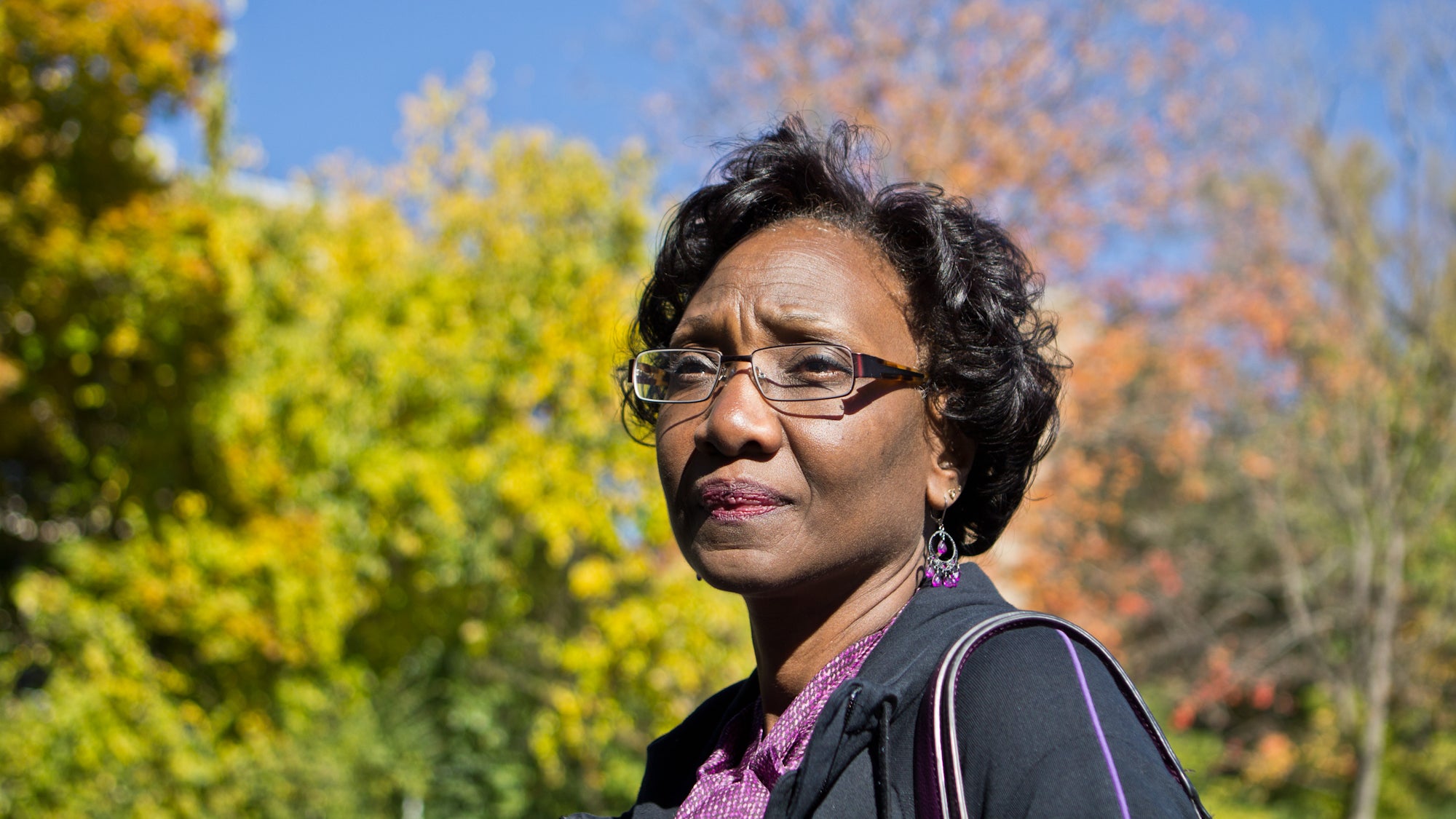Figuring out the future when illness is your new normal
Listen
Cheri Perron said she wants other people with lupus to know it’s not a death sentence. (Kimberly Paynter/WHYY)
When something goes wrong, we all hope a doctor will find the problem and fix it, so that sooner or later, we can get back to our real life. But sometimes it takes years to figure out what’s wrong. For certain conditions, there’s no cure.
When something goes wrong, we all hope a doctor will find the problem and fix it, so that sooner or later, we can get back to our real life. But sometimes it takes years to figure out what’s wrong. For certain conditions, there’s no cure. For others, the available treatment just-barely manages symptoms.
Author and physician Paul Offit says many patients are desperate for a diagnosis and treatment but occasionally, he has to deliver the news that “medicine has limits.”
“People want certainty. If they have symptoms, especially symptoms that are debilitating, they want certainty. That’s why someone like Bones in ‘Star Trek ‘is so attractive. He had his little handheld monitor and he’d go up and down and he’d look at it and that’s what you had. That’s what you would like to think all doctors can do, but we can’t,” said Offit, a pediatrician at the Children’s Hospital of Philadelphia.
Millions of Americans are living with a chronic illness. We spoke with three of them.
Molly Dennis
Dennis is young and single in the city–and tired all the time. She has lupus.
Since puberty, she’s felt just a little bit unwell.
“More often than not, my physicians would say, well, I think you are maybe depressed, or maybe you just need to get a better night’s sleep. Things like that. It was never taken seriously,” said 29-year-old Dennis.
Maybe because she was very young when her symptoms first started, the doctors just didn’t seem to really hear her when she complained.
A decade later, she was still exhausted most days, sucking it up and living with freezing cold, painful feet. Then after switching to a new doctor, Molly learned she has lupus, an illness where the immune system ‘gets confused’ and starts attacking different parts of the body.
“I always joke that my body just hates itself,” Dennis said.
There’s good treatment to keep her disease in-check. But Dennis says it’s frustrating knowing she’ll never be well again.
“Not only is it not going to go away, you have no way of predicting how it’s going to affect you. In two weeks I could be in the hospital. I’m a planner, I want to know what’s happening, and this is something that will not let me do that,” she said.
The first year after her diagnosis, Dennis says she cycled through different feelings. Denial was first, then some anger and depression. Five years later, she’s found a wavering acceptance.
“I am doing very well, don’t get me wrong. If you ask my doctor he would tell you I’m in remission. But I don’t know how I feel about that terminology though, I always feel like I have lupus. I always feel the effects. I always have those days where I can’t keep my eyes open,” she said.
In recent years, her doctor recommended a medicine that eases Dennis’ foot pain. She found a support group and she decided to transform herself into a runner.
“I had a partner at the time and I remember looking at him: ‘I’m going to start running.'” she told him.
Her partner rolled his eyes a little at the thought that Dennis was actually going to get up off the couch.
But “I did,” she says.
This fall, she ran her fifth 5K race for charity, the Lupus Loop. Dennis says she’s never felt so accomplished.

Molly Dennis, right. (Courtesy of Molly Dennis)
Emily Suess
Emily Suess has fibromyalgia, a condition that comes from chronic sleep problems. Suess deals with all-over muscle aches and body tenderness. Just sitting for too long or putting on a bra sends pain messages to her brain. You can even hear that constant struggle in her voice. It’s a bit shaky and Suess says unsteady is how she feels a lot of the time.
Suess lives in Central Illinois with her husband—her dog Boomer and cat named Izzy. In real life, she has a circle of people who support her, but it might be her online community that helps the most, she said.
“These people are my friends. I call them my internet BFFs,” Suess said.
On Twitter and on her blog, Suess connects with people who are also dealing with an illness that’s not going away. They post funny videos, create GIFs – and find each other with hashtags: #chroniclife #chronicpain or #spoonielife.
The “spoon” theory is a metaphor that people use to describe the way a chronic illness or disability can sap energy or curb what they are able to do each day.
On the Internet, Suess says she doesn’t have to keep up appearances.
“You kind of need to talk to somebody who just gets it. And it’s a way to kind of give my caregiver, my husband, a break from having to listen to me all the time, because it’s every day, it’s all day, it never stops,” she said.
It’s been two and a half years since she’s gotten a good night’s rest. When she describes her condition to friends, Suess says it’s like her stress response is stuck on high alert. There were lots of tests on the path to her diagnosis.
“He touched points on the upper back, around my neck, around elbows and knees and he sent shock waves through my body with that, to the point where my knees buckled at one point,” Suess said.
Twitter friends give Suess a boldness she says she never had before. She was raised to respect and defer to authority—the idea that “the doctors know best.”
“Dealing with this illness, I kind of had to re-learn everything. When I’m in some situations, I almost feel that I have to be combative to get my point across or to get the treatment or care I need,” she said.
A few weeks ago, for the first time, Suess admitted to herself–and announced on her blog—that having a debilitating illness is her new normal.
“Up until that point, I had kind of seen myself as this healthy person just waiting for her luck to change. Like one day this is all going to be over and I won’t have to deal with it anymore,” Suess said.
Cheri Perron
Many people have a similar moment of realization about the reach of their illness.
For Cheri Perron—one of those moments came about 10 years ago while she was sitting in her car. She has a kind of lupus that causes thinking problems. She was walking out of her job at the end of the day and suddenly got confused. So she called her husband.
“He said, ‘Where are you? I said I’m at work, I’m in the parking … ‘What do you mean you can’t get home?’ I said I don’t remember how to get home, I just don’t remember,” Perron remembers. So her husband had to stay on the line and give her turn-by-turn directions.
“Sometimes it’s a low simmer, sometimes it boils over,” she said.
She lives with severe fatigue and swollen hands.
“I’m in pain every day,” Perron said. “I guess at my worst, my hands really looked like baseball mitts.”
She’s been living that way for 20 years, and was first diagnosed when her children were age two and four. The stiffness in her hands made it difficult to ring out a face towel, do her daughters hair or the other bath, dinner, homework chores she needed to do as a mother.
Her pain and memory lapses have been socially isolating but Perron says she gets comfort from volunteering. Her activism is on display every day. Peak in her closet and it’s a sea of mauve.
“Somebody will say, didn’t I see you in purple yesterday? ‘Yes.’ You wear purple everyday? ‘Yes.’ Why do you wear purple? ‘Because I have lupus,'” said Perron, who was wearing plum corduroy pants, boysenberry suede shoes and purple bracelets.
Like pink for breast cancer, purple is the awareness color for lupus.
“My wedding ring has a purple stone in it,” she said.
Perron doesn’t work anymore; she’s officially disabled today. But a couple times a week she volunteers for the Lupus Foundation of America. It’s a struggle to walk the 75 feet from the parking lot to the office building.
“I’m tired, a little winded, still achy,” she said.
After a few quiet moments to recover and a sip of her tea, Perron spent the afternoon on the phone taking calls and speaking with other people, newly diagnosed with lupus.
“I have to live out what I’m telling other people and I can’t sit there and say it’s going to be OK, if I don’t believe that’s going to be the case,” she said.
Autoimmune diseases
There are about 23 million Americans living with an autoimmune disease—an umbrella term for about two dozen different conditions.
Some of those illness are three times more common now than they were several decades ago. They include illnesses you’ve heard of — multiple sclerosis, celiac disease, scleroderma—and 80 percent of Americans diagnosed with an autoimmune disease are women.
Joan Von Feldt, who’s on the board of the American College of Rheumatology, says health officials aren’t exactly sure why. But she said better diagnostic tests and better awareness don’t fully account for the swift rise in the number of people with autoimmune diseases.
Just a short list of triggers—not causes–have been definitely linked to autoimmune disease–the sun, smoking, some kinds of dust, certain kinds of radiation, and certain pesticides.
Rheumatologist Joan Von Feldt explains that an autoimmune disease is like a case of mistaken identity, inside the body. The immune system starts to do battle with it’s own cells or tissues—as if they were foreign invaders.
With alopecia—it’s the hair follicles. With Celiac disease, the lining of the intestines is under attack. In the case of rheumatoid arthritis, the body thinks the joints are an enemy.
“So there’s a lot of fluid in the joint, and so the joint swells, and it’s painful when it gets swollen, and it gets stiff, so the joint doesn’t move very effectively,” Von Feldt said.
In recent years several celebrities including singer Toni Braxton, pop star Selena Gomez and Kim Kardashian revealed they’ve been diagnosed with an autoimmune disease. And that news has helped activists push for more clinical research to find better treatments and cures.
Activists argue that the United States is a bit behind in investing dollars in research and investigating the immune system.
Cancer for example started getting lots of national recognition and research investment back in the 1960s. But it wasn’t until the late 90s, and early 2000s when the U.S. stepped-up research on autoimmune diseases and established research Centers of Excellence around the country.
WHYY is your source for fact-based, in-depth journalism and information. As a nonprofit organization, we rely on financial support from readers like you. Please give today.



